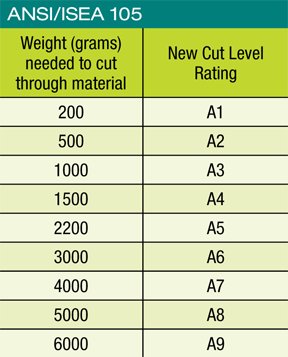New standards offer greater hand protection
By Rich Vurva
![]() A new hand-protection standard introduced earlier this year offers a more accurate way to understand the cut resistance level of gloves. The American National Standards Institute and the International Safety Equipment Association updated the ANSI/ISEA 105 Standard for the first time since 2005. The changes include new classification levels and a new scale to determine cut score, commonly referred to as the ANSI cut score. There’s also a revised method for testing gloves to make sure they meet the standard.
A new hand-protection standard introduced earlier this year offers a more accurate way to understand the cut resistance level of gloves. The American National Standards Institute and the International Safety Equipment Association updated the ANSI/ISEA 105 Standard for the first time since 2005. The changes include new classification levels and a new scale to determine cut score, commonly referred to as the ANSI cut score. There’s also a revised method for testing gloves to make sure they meet the standard.
The new ANSI standard features nine cut levels, from A1 (light cut hazards) to A9 (high cut hazards), measured in grams of cut pressure, with smaller increments between levels. The old standard had just five levels. Under the new designation, a glove marked A1 is designed to provide protection for up to 200 grams of cut resistance while the A9 level offers protection for up to 6,000 grams of pressure.
 Glove suppliers have already begun to mark gloves with the new designation.
Glove suppliers have already begun to mark gloves with the new designation.
In addition, the new standard also outlines a new test method for determining the cut scores. The new ASTM F2992-15 test method allows for only one type of machine to be used, the TDM-100. Under the old standard, testing could be performed on more than one machine. Ensuring uniform testing with one machine makes it easier to compare gram scores for a given material.
The changes came about as new materials, yarns and technologies were introduced that dramatically improved the performance of work gloves. For users, that also has translated into gloves that are more comfortable to wear, lighter weight, and provide better dexterity and fit.
“New technologies and materials available today are more comfortable and light weight, so the worker will wear it and not take it off, which reduces hand injuries. The worker needs to be confident that the glove is going to protect him for whatever he is doing,” explains Bob Kelsey, product manager for gloves for Radians, a Tennessee-based supplier of personal protective equipment.
Hand injuries are the second leading cause of work-related injuries. According to the Bureau of Labor Statistics, 70 percent of hand injuries occur because workers don’t wear hand protection because of dexterity issues.
Often, a worker will pick up a pair of gloves at the beginning of the shift, and remove them whenever he needs to use a touch-tone phone, pick up a fastener, or simply because the glove is too bulky or hot. Eventually, the worker doesn’t bother putting the gloves back on.
 |
| Bob Kelsey |
“With gloves being manufactured today that are designed for specific applications, you definitely get a better fit and a better feel. The key is to get the right glove for the application,” Kelsey adds.
For example, elastic cuffs offer a comfortable slip-on fit to make them easier to put on and take off, coated palms provide a slip-free grip, and sandy foam nitrile palm coating offers protection from abrasion in wet or dry applications.
With so many options, Kelsey recommends that distributors should let their suppliers be more involved with their sales team and their end users.
“I’d like to see more distributors invite suppliers to ride along with their sales guys and make calls on end users. You can conduct glove audits in the factory and on construction sites to see which glove is specific for the job,” Kelsey says.
This article originally appeared in the Sept./Oct. 2016 issue of Industrial Supply magazine. Copyright 2016, Direct Business Media.













